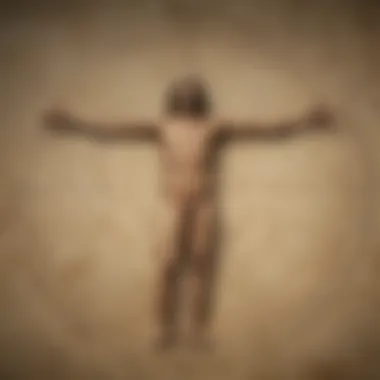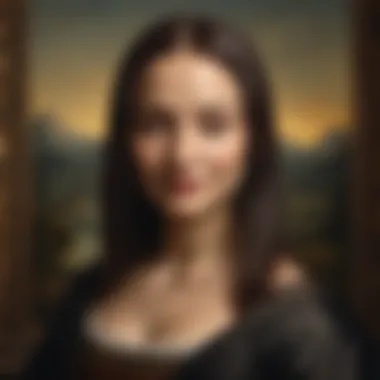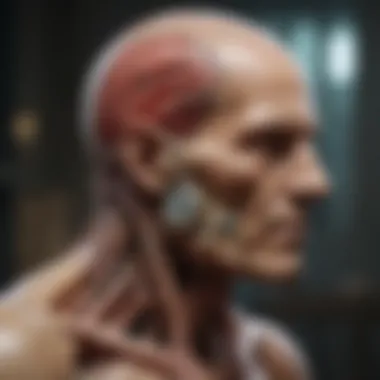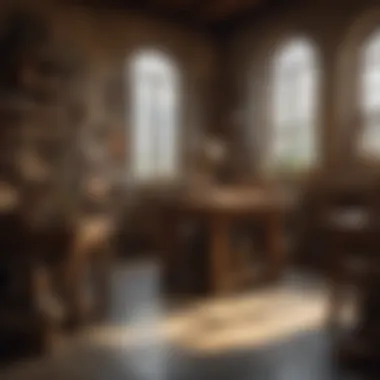Exploring Leonardo da Vinci: Insights from Isaacson


Intro
Walter Isaacson's examination of Leonardo da Vinci is not just a biography; it’s a deep dive into the mind of a man whose talents transcended the boundaries of his time. This exploration reveals a figure who embraced a curiosity that knows no bounds. From painting the Mona Lisa to designing intricate machines, da Vinci exemplified what it meant to be a Renaissance polymath.
Isaacson's work tackles the interplay of creativity and scientific inquiry, and how these elements combined to shape the world we know today. For the modern reader, the book serves as both inspiration and a guide. It highlights not only the genius of da Vinci but also practical lessons that can be echoed in personal and professional paths.
As we meander through the intricacies of da Vinci's life, we begin to understand the relevance of his interdisciplinary approach. This article will piece together insights from Isaacson's narrative and underscore key themes that resonate deeply even in today's fast-paced society.
Preamble to Walter Isaacson’s Work
Walter Isaacson's exploration of Leonardo da Vinci offers a multifaceted perspective on one of history’s most esteemed figures. Examining da Vinci's life and works under Isaacson’s keen analysis provides readers with a rich tapestry of insights, where creativity meets intellect. Importantly, this introduction serves as a gateway into understanding how Isaacson unpacks the genius that is da Vinci, transcending mere biography and engaging with the reasons behind da Vinci's enduring influence.
A key element of Isaacson's work is its comprehensive nature. He draws upon various sources, including da Vinci's own notebooks, to flesh out not just the artist but the thinker, the inventor, and the scientist. Isaacson adeptly weaves these details into a narrative that encourages readers to appreciate the interconnectedness of art and science. Through his writing, he illuminates the significance of da Vinci's curiosity—an insatiable quest for knowledge that propelled him to innovate and create.
Why does this matter? Well, readers of all backgrounds can find something valuable in da Vinci’s story. The fusion of disciplines within da Vinci's work acts as a potent reminder of the importance of interdisciplinary thinking, something that resonates strongly in our fast-paced, complex modern world. Moreover, by dissecting Isaacson’s interpretations, we can extract valuable lessons about creativity, passion, and perseverance, which remain relevant today.
It is also crucial to recognize the historical context in which Isaacson places Leonardo. The Renaissance was a period of unparalleled innovation where traditional boundaries began to dissolve. In exploring this, Isaacson contextualizes da Vinci’s work within broader movements, making it clear that da Vinci wasn't merely an outlier; he was at the forefront of a transformation that shaped Western thought and culture.
In summary, the introduction to Isaacson’s exploration not only sets the tone for a detailed investigation of da Vinci's legacy but also underscores the relevance of his genius in today’s world. This assessment opens the door for deeper engagement with the upcoming sections, which will dissect various aspects of da Vinci’s life and work in much detail.
Understanding Leonardo’s Early Life
Leonardo da Vinci's early life is a fascinating tapestry woven with threads of creativity, curiosity, and inspiration. His childhood experiences and education laid the groundwork for his extraordinary intellect and talent. Understanding this formative period offers invaluable insights into how he evolved into one of history's most celebrated figures.
Childhood Influences on Da Vinci's Development
From the get-go, Leonardo's upbringing in Vinci, a small town in Italy, played a significant role in shaping his mind. Born out of wedlock in 1452, he was raised by his father, a notary, and his mother, who worked as a peasant. This unique family dynamic exposed him to disparate worlds, nurturing both intellectual and artistic inclinations.
- Nature and Environment: Surrounded by lush countryside, young Leonardo found inspiration in natural phenomena. He became deeply observant of the world around him, captivated by the movement of water, the flight of birds, and the intricate patterns in leaves. This connection to nature would later permeate his art and scientific inquiries.
- Art as a Means of Communication: Growing up, Leonardo was not isolated from the artistic community. His exposure to artisans and local craftsmen provided him with the early lessons essential to his later work. Craftsmanship became a language through which he expressed his burgeoning ideas and creativity. Even in his youth, he was a keen observer, sketching the vivid landscapes of his hometown and the vivid colors of the Florentine countryside, serving as a precursor to the masterpieces he would later create.
"As a young boy, I gazed upon the marvels of the earth, seeking to capture its secrets through the stroke of my hand."
Education and Training in Renaissance Florence
When Leonardo turned fourteen, his family made the pivotal decision to send him to Florence—a hotbed of Renaissance art and thought. This move would ultimately mark the turning point in his life.
- Apprenticeship: In Florence, Leonardo caught the attention of Andrea del Verrocchio, a leading artist and master. Under Verrocchio's tutelage, da Vinci learned painting, sculpture, and even technical skills like metalworking. This apprenticeship exposed him to the intricacies of Renaissance art and the grandeur of human expression, fostering his own artistic vision.
- Intellectual Atmosphere: Florence was vibrant, bustling with scholars, poets, and thinkers debating humanism, science, and philosophy. Leonardo was like a sponge, absorbing ideas and approaching knowledge with unrelenting curiosity. Unlike many of his contemporaries, who focused primarily on religious imagery, da Vinci sought to explore themes of nature and humanity in ways that were fresh and innovative.
- Methodical Observation: His education was not just confined to paint and canvas; it extended to anatomy and mathematics. Leonardo immersed himself in studies of the human body, dissecting cadavers— a radical practice at the time. This intense curiosity forged a connection between his artistic and scientific pursuits, establishing a multidisciplinary foundation that defined his later work.
Through these early experiences, da Vinci laid the groundwork for the interdisciplinary approach that would become his hallmark. Young Leonardo was not just learning art; he was developing a framework for inquiry that would allow him to merge disciplines in ways that had never been approached before. His childhood and formative years in Florence were not merely a backdrop; they were the very crucible in which his genius was forged.


Da Vinci's Artistic Mastery
Leonardo da Vinci's mastery of art goes beyond mere brush strokes on canvas. It represents a confluence of techniques, ideas, and emotional depth, which redefined the boundaries of artistic expression. This section uncovers the pivotal elements that demonstrate the brilliance behind da Vinci's artwork, showcasing how his insights mirror the complexities of human experience and the natural world. Understanding his artistic prowess not only opens a window into the Renaissance era but also enriches our appreciation of artistry in contemporary society.
Analysis of Iconic Works: The Last Supper
The Last Supper is arguably one of the cornerstone pieces in da Vinci's oeuvre. Painted between 1495 and 1498, this mural captures the moment Jesus announces that one of his disciples will betray him. Da Vinci doesn’t merely depict a moment in biblical history; he infuses it with human emotion and tension. The arrangement of figures draws your eye to the central figure of Christ. Each apostle's expression and gesture conveys a range of emotions from disbelief to anger, which makes the scene come alive in a way that previous depictions did not.
The use of perspective is particularly striking. Da Vinci creates a sense of depth through linear perspective, inviting the viewer into the composition as if they were part of the gathering. This technique accentuates his understanding of spatial relationships, making it a masterclass in both art and architecture. Moreover, his innovative activities in the use of chiaroscuro add to the emotional impact, emphasizing the light and shadow that envelops the characters, therefore narrating a story that transcends time.
The Techniques Behind the Mona Lisa
The Mona Lisa, painted between 1503 and 1506, is perhaps da Vinci's most famous work, and rightfully so. It presents not just a portrait but an exploration of psychological depth. The technique da Vinci employed—sfumato—creates a soft transition between colors and tones, which gives the subject an almost ethereal presence. Rather than defined lines, the blending of shades imbues the face of Lisa Gherardini with a sense of life and ambiguity. This is notably apparent in her enigmatic smile, eliciting varying interpretations from viewers.
Furthermore, the gaze of the Mona Lisa is designed to create a connection with the observer. The way her eyes seem to follow viewers around the room is a testament to da Vinci's technical skill and understanding of human interaction in art. This painting does not merely portray a woman; it invites the audience into dialogue, making them ponder her thoughts, feelings, and reactions. Such depth in engagement sets da Vinci apart from his contemporaries.
Innovative Use of Color and Light
Da Vinci’s innovative approach to color and light fundamentally altered art. His understanding of atmospheric perspective revolutionized how depth and distance are portrayed. He employed shades and colors to create visual planes, drawing the eye back into the painting. For instance, in landscapes, differing colors can suggest varying distances, which not only captivates the viewer but also renders a more realistic environment.
Moreover, da Vinci's employment of light as an artistic tool also reflects his scientific curiosity. He studied how light interacts with surfaces and textures, which informed his approach to realism. In The Virgin of the Rocks, his dramatic use of light enhances the emotional intensity of the composition, distinguishing the characters and directing the viewer's focus. Such innovative techniques encapsulate da Vinci's intimate relationship with nature and his relentless quest for knowledge.
"Leonardo's works are not merely art; they are the culmination of his observations, experiments, and relentless curiosity about the world around him."
In summary, Leonardo da Vinci's artistic mastery encompasses a spectrum of innovations and techniques that not only revolutionized the art world but also serve as inspiration for modern artists and thinkers. His ability to weave together emotional depth, technical precision, and intellectual pursuit continues to resonate, emphasizing the enduring relevance of his genius.
The Interdisciplinary Nature of Da Vinci's Work
Leonardo da Vinci exemplified the rare blend of artistic talent and scientific inquiry that defined the spirit of the Renaissance. His work cuts across various domains, showcasing the remarkable interplay between art and science, which is at the core of Isaacson's exploration. Understanding this interdisciplinary nature not only sheds light on da Vinci's genius but also illustrates how such an approach can still inspire contemporary innovation and creativity in various fields.
Blending Art and Science
One of the most striking aspects of da Vinci’s oeuvre is his seamless integration of art and science. While he is often celebrated for masterful paintings like the Mona Lisa and The Last Supper, lesser-known are his meticulous notebooks filled with anatomical sketches and scientific observations. Da Vinci viewed the world through a lens that combined observation, experimentation, and creative expression.
His scientific inquiries informed his artistic techniques. For instance, through his study of light, shadow, and perspective, he created depth in his paintings, enhancing their realism. Da Vinci's dissections of cadavers led to unparalleled understanding of human anatomy, allowing him to represent human form with incredible accuracy. This blending of disciplines reflected a belief that appreciation for the natural world was crucial for any artist, a notion that resonates even today.
Impact of Anatomy on Artistic Representation
Anatomy played a pivotal role in da Vinci’s approach to art, bridging the gap between a scientific understanding of the human body and creative expression. He meticulously documented his anatomical studies, analyzing muscles, bones, and internal organs, laying the foundation for future artists and medical professionals alike.


His confidence in portraying human figures stemmed from these extensive studies. For example, da Vinci's sketches reveal his insight into the way muscles contracted and relaxed, leading to more dynamic and lifelike representations. The ability to capture movement and emotion in a static medium set his work apart.
"Art is the queen of all sciences communicating knowledge to all the generations of the world."
— Leonardo da Vinci
When looking back at his pieces, one can often trace the influence of his anatomical understanding. The gracefulness of the figures in his paintings, the intricate detailing showcased in his sculptures, all hint at the deep connection he fostered between art and science.
Engineering and Invention: A Dual Identity
Da Vinci's identity as a painter was matched only by his prowess in engineering and invention. His notebooks are filled with designs for machines and inventions that were centuries ahead of their time, from flying machines to armored vehicles. This dual identity showcases how his artistic skills influenced his technical endeavors.
He approached engineering with the same curiosity that characterized his artistic processes. The designs were not mere blueprints; they reflected his artistic sensibility, illustrated with sketches that provided both practicality and aesthetic appeal. His understanding of materials, structural integrity, and motion linked back to his explorations of human anatomy and natural phenomena.
In today's fast-paced world, the interdisciplinary methodology that da Vinci embodied serves as a powerful reminder of the importance of crossover knowledge. His life’s work teaches that creativity flourishes when we break down silos and embrace an integrative approach to problem-solving—an invaluable lesson for professionals in any field. Autonomy in thought, the curiosity to ask questions, paired with the courage to experiment, can lead to innovations that significantly transform industries.
Da Vinci's Intellectual Curiosity
Leonardo da Vinci's intellectual curiosity serves as a cornerstone in understanding not only his life but his extraordinary contributions to various fields. This pursuit of knowledge was marked by an insatiable desire to explore, question, and understand the world around him. Unpacking this curiosity gives insight into how da Vinci's mind worked, revealing a framework for creativity that is relevant today.
The Role of Questions in His Pursuit of Knowledge
One of the most striking features of da Vinci's intellectual journey is his relentless questioning. He approached every subject with a critical eye. This inquisitiveness was not merely a passive trait; instead, it propelled him to probe into the mechanisms of nature and art.
Questions he often pondered included:
- What are the reasons behind the motion of water?
- How do light and shadow interact?
- Why do certain forms of nature resonate with artistic beauty?
By framing these queries, da Vinci was not just seeking answers; he was setting the groundwork for future discovery. His famous aphorism "Just as the sun transforms all into light, so does understanding illuminate the dark paths of ignorance" illustrates how he viewed knowledge as a guiding light.
"Simplicity is the ultimate sophistication."
– Leonardo da Vinci
Journals as a Reflection of Thought Process
Da Vinci's journals serve as a window into his thought processes. Filled with sketches, notes, and half-formed ideas, these manuscripts showcase his rambling yet rigorously structured approach to thinking. In his journals, one finds iterations of ideas that would become iconic, alongside mundane observations that reveal his everyday curiosity.
These written reflections not only demonstrate the evolution of his thoughts but also highlight the interconnections between disparate fields. His illustrations of the human body, for example, appear alongside notes on flight and mechanics. This shows how he synthesized knowledge from various disciplines, which was rightly appreciated by Isaacson.
The meticulous nature of his journaling can remind modern readers and thinkers of the power of documentation. Keeping track of questions, thoughts, and reflections encourages a similar habit of critical engagement with the world.
Influence and Legacy of Leonardo da Vinci


Leonardo da Vinci stands as an enduring figure whose influence reaches far beyond his time. His diverse talents and insatiable curiosity not only shaped the Italian Renaissance but also laid foundations that continue to inspire artists, scientists, and thinkers to this very day. Understanding da Vinci’s legacy provides valuable insights into the profound connections between creativity and knowledge, showcasing how his methods and ideas can be integrated into modern life.
The resonance of da Vinci's work can be examined through two key prisms: the impact he has had on contemporary artists and thinkers, and the timeless lessons that emerge from his multifaceted life.
Impact on Contemporary Artists and Thinkers
The seeds of inspiration that da Vinci planted can be seen across various domains of artistic and intellectual endeavors. Contemporary artists, whether they wield a paintbrush or employ digital technologies, often draw from da Vinci's principles of observation and experimentation. Many modern painters echo his techniques such as the sfumato, blending colors and forms in a way that adds depth and emotion to their work, similar to how Leonardo portrayed subtle expressions in the Mona Lisa.
Furthermore, thinkers in fields like architecture, design, and engineering continually reference da Vinci's innovative spirit. His relentless pursuit of knowledge and mastery of multiple disciplines urges current leaders in these fields to look beyond their specific areas of expertise. By constantly shifting gears, much like da Vinci did with his engineering projects and botanical drawings, today’s professionals are enabled to bridge gaps between disciplines, creating solutions that are as creative as they are effective.
Society can benefit from revisiting Leonardo’s emphasis on curiosity. As a renowned polymath, his cross-disciplinary methods serve as a blueprint for breaking down silos in academia and industry alike. In a world that values specialization, Leonardo’s model encourages breadth over depth, prompting individuals to be both inquisitive and versatile.
"Study the science of art, study the art of science; develop your senses—especially learn how to see."
Enduring Lessons from da Vinci’s Life
Leonardo da Vinci’s life is rich with lessons that extend well into the current age, particularly regarding the pursuit of knowledge and creativity. His journals, filled with sketches, reflections, and observations, embody a commitment to lifelong learning that is particularly relevant today. These writings highlight the importance of not only acquiring facts but also engaging critically with questions.
Among the various lessons we can glean from Leonardo’s pursuits are:
- Embrace Failure: Da Vinci faced numerous setbacks, whether in art or engineering. Understanding failure as a part of the creative process allows individuals to iterate and innovate without being discouraged.
- Cultivate Curiosity: Experiencing the world with childlike wonder, as da Vinci did, opens doors to exploration. Keeping a curious mind enables one to ask questions that can lead to breakthroughs.
- Interdisciplinary Collaboration: Leonardo's work exemplified the fusion of art and science, demonstrating that the mingling of different fields can yield extraordinary results. This lesson encourages today’s professionals to collaborate across various sectors for innovative solutions.
As we dissect the narratives that da Vinci left behind, it’s crucial to recognize that his legacy is not merely historical; rather, it is a living testament that urges us to continue striving for greatness, embracing curiosity, and remaining open to the wealth of knowledge that exists around us.
Closure: Extracting Modern Relevance
In a world increasingly defined by specialization, Leonardo da Vinci's story stands as a beacon of interdisciplinary ingenuity. Walter Isaacson’s exploration of da Vinci urges us to draw parallels between the past and the present. By analyzing da Vinci’s life, we uncover numerous principles that can be implemented today, transcending personal and professional realms, shedding light on the vast, interconnected nature of knowledge.
Understanding da Vinci's approach offers a profound insight into how innovation often emerges at the intersection of diverse fields. His relentless quest for knowledge, from anatomy to painting, showcases the value of looking beyond one’s immediate domain. In today’s fast-paced environment, an interdisciplinary mindset is not only beneficial but often necessary. The relevance of his principles extends into various modern sectors, including technology, education, and business.
Applications of Da Vinci's Principles in Today’s World
Leonardo's multifaceted skills remind us of the importance of versatility. In contemporary contexts, we can apply his principles in different ways:
- Innovation Through Collaboration: Just as da Vinci worked across domains, modern projects benefit from team collaboration embracing diverse experts. This cross-pollination often leads to groundbreaking solutions.
- Embracing Curiosity: Encouraging a culture where questioning is welcomed can lead to discoveries equally profound as those da Vinci pursued. Organizations should foster an environment where employees feel free to explore and challenge conventional wisdom.
- Hands-On Learning: Da Vinci was known for his extensive practice in various crafts. Today’s educational systems are increasingly recognizing the importance of experiential learning, suggesting that students benefit greatly from hands-on experiences.
- Art and Technology Fusion: Modern artists and technologists are often merging disciplines, just as da Vinci did. User experience design, for instance, often utilizes principles of artistry merged with technology to create compelling solutions.
Encouragement of Lifelong Learning and Innovation
Da Vinci’s life embodies the essence of lifelong learning. His curiosity never waned; he was always on the lookout for new knowledge and skills. This trait is particularly significant today, where rapid changes often require ongoing education to stay competitive.
In a brightly lit era of information access, it is vital to instill the love of learning within both personal and professional realms. This can be achieved by:
- Encouraging Reading and Exploration: Just as da Vinci filled his notebooks with ideas, modern individuals should cultivate a habit of reading broadly. This can lead to unexpected connections and innovations.
- Networking and Idea Sharing: Engaging with different circles can stimulate new ways of thinking. Discussions with individuals from varied backgrounds can often lead to innovative concepts that one may not have considered before.
- Continuous Skill Development: In the spirit of da Vinci, individuals should commit to honing their skills, whether through formal education, online courses, or self-guided study. This aligns with the necessity of adaptability in rapidly evolving careers.
"Learning never exhausts the mind." - Leonardo da Vinci
In summation, da Vinci’s life serves as a compelling reminder of the power of an inquisitive mind and the endless possibilities lying at the intersection of art and science. By embracing his principles today, individuals and organizations alike can work towards a future that values creativity, innovation, and the pursuit of knowledge.







